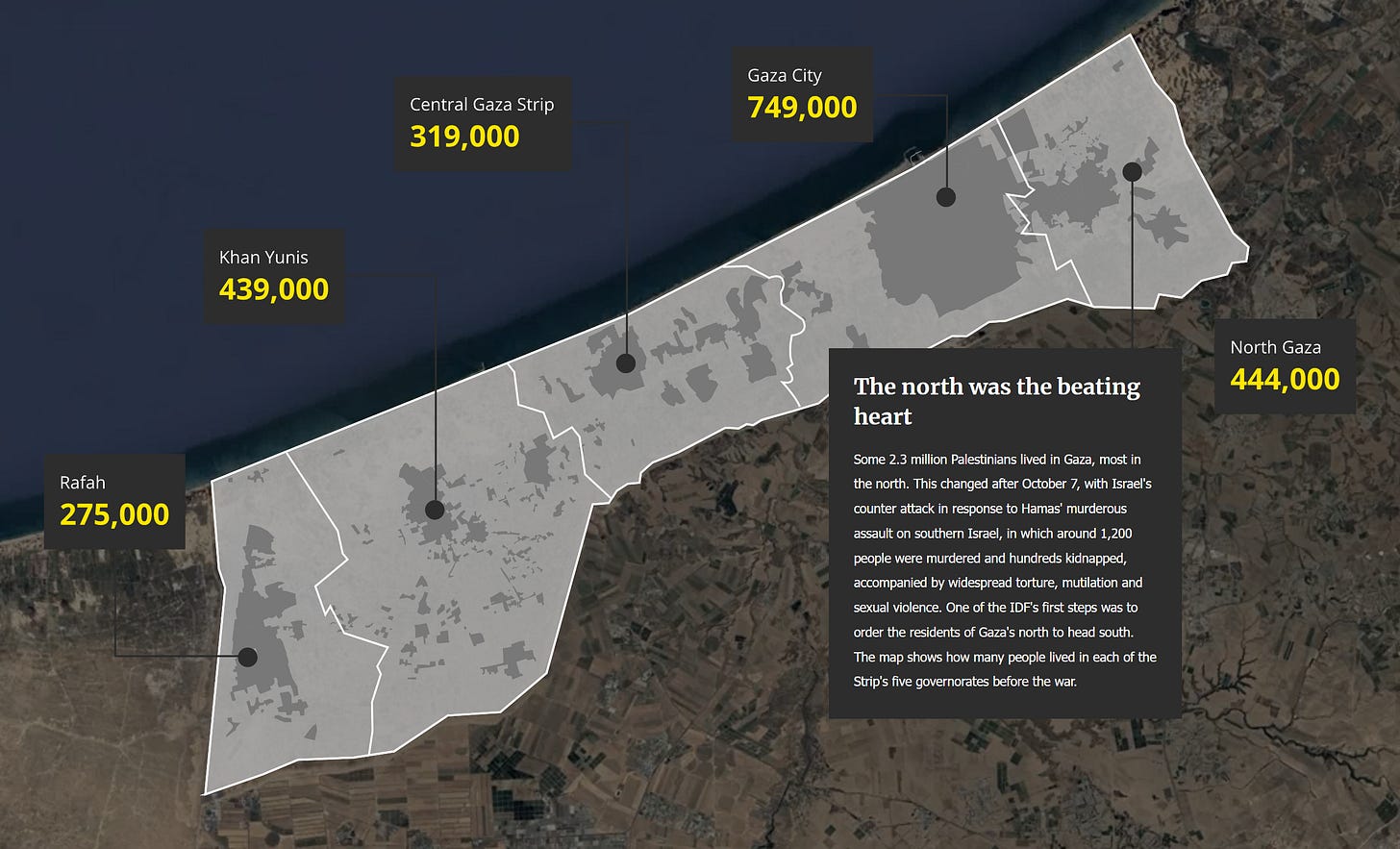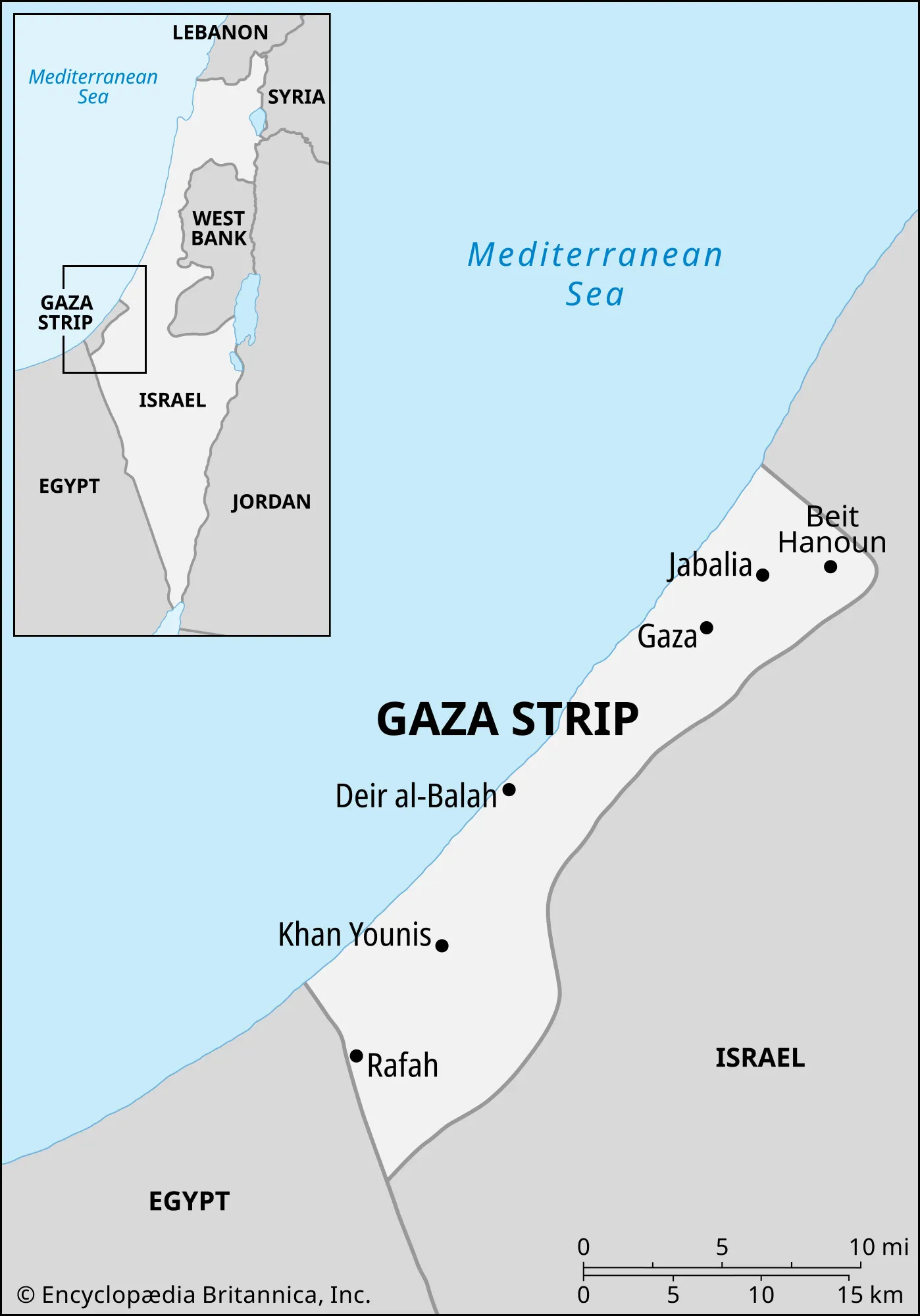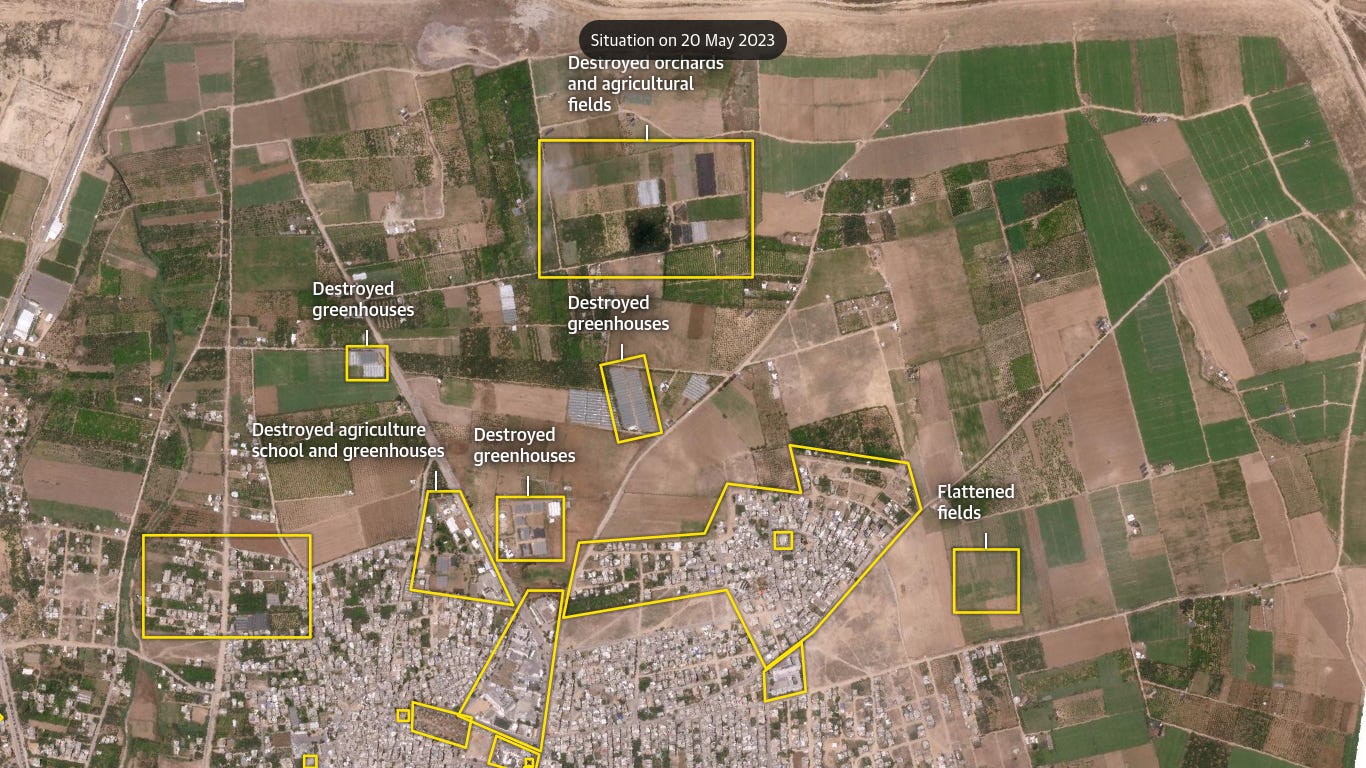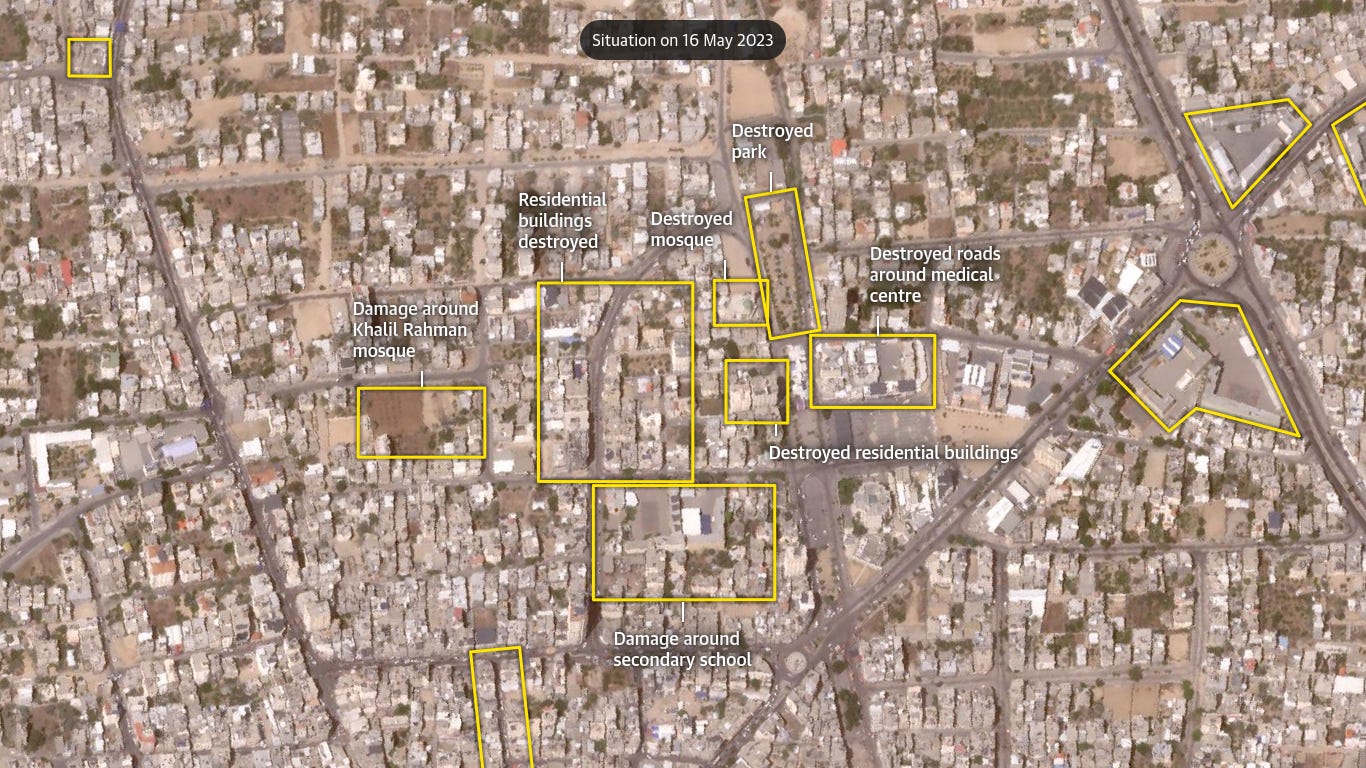NEWS ANALYSIS: Visualizing Israel's War Of Annihilation
Massive destruction of civilian infrastructure, including hospitals, neighborhoods, natural resources, and educational institutions reveal Israel's intent to depopulate the entire Gaza strip.
The destruction in Gaza is so extensive that it can be seen from space. British newspaper The Guardian’s investigation built on research from the City University of New York and Oregon State University. Based on satellite data, they concluded that of “between 50% and 62% of all buildings in Gaza have likely been damaged or destroyed.”
These are clearly not military targets; they are the necessary structures of everyday life. Yet an IDF spokesperson told the newspaper that destroying this infrastructure was “imperatively required to achieve the goals of the war.” Here again we have an Israeli admit flat out that the goals of war include depopulation.
Recently, the Israeli paper Haaretz published their own visual investigation into the destruction. Here we can clearly see the population centers…
…and what Israel did to them in the last 4 months:
In its visualization, The Guardian focuses on three localities: Beit Hanoun, in the far northeast; Al-Zahra, south of Gaza City; and Khan Yunis, in the southeast. The profile highlights “damage to more than 250 residential buildings, 17 schools and universities, 16 mosques, three hospitals, three cemeteries and 150 agricultural greenhouses.”
Beit Hanoun
The city, with a population of about 50,000, was fully occupied by the IDF in December. The farmland and greenhouses that previously dotted the landscape have been damaged, along with 150 residential buildings and several schools. The Beit Hanoun Hospital was severely damaged and the Balsam hospital was destroyed. The Guardian also found that a cemetery had been bulldozed and the historic Umm Al-Nasr mosque, which has parts dating to 1239, destroyed.
Al-Zahra
Home to about 5,000 residents before the war, Al-Zahra was one of the most affluent areas in central Gaza. The neighborhood boasted three universities, which are now severely damaged; one, Israa University, was partially demolished by the IDF. Tower blocks that once housed 3,000 people were also leveled. Israeli armored vehicles created visible paths through the neighborhood’s agricultural land. A wastewater treatment plant to the north of the area had several surrounding buildings destroyed.
Khan Yunis
This city of about 425,000 originally hosted internally displaced persons from the northern region of the Gaza Strip, but since the IDF escalated its military activities in December, its infrastructure has suffered heavy damage. Alongside residential buildings, fields, greenhouses, sports areas, pharmacies, and grocery stores, the Israeli military targeted Khan Yunis refugee camp, home to 41,000 people in 2017.
Genocide in Gaza by the Numbers
The men, women, and children of Gaza are not suffering from the collateral damage that usually accompanies a war. They are the targets of a coordinated campaign of genocide, one that Israel has waged since 1948. Since October 7, Israel has dramatically escalated this campaign. Its military assaults on basic infrastructure have caused a brutal humanitarian crisis in Gaza that shows no signs of ceasing. Medical facilities, food, the land, natural resources, homes, universities, schools — none are safe from Israel’s merciless war.
Hospitals and Medical Care
Of the 36 hospitals in the Gaza strip, 21 are no longer functioning, 13 are functioning partially, and 2 are functioning only minimally. Medical supplies, medicine, and electrical generators are in short supply.
In the southern city of Khan Yunis, Israeli drones struck Al-Amal hospital and tanks approached the largest functioning hospital, Nasser.
Even temporary hospitals are not safe. A Jordanian field hospital, also in Khan Younis had its entrance blocked by an Israeli tank while shells were fired at the bunkers where staff had taken shelter.
As of January 18th, there had been 645 attacks on hospitals, ambulances, and supply vehicles in Palestine. Meanwhile, the IDF continues to insist that it is only targeting militant groups.
Food and Natural Resources
Even before the war, Israel’s blockade made starvation an everyday presence for the people of Gaza. About 80% of the population relied on humanitarian aid and 44% of households suffered food insecurity. Since October 7, the situation has only worsened; the latest estimates place 93% of Gaza’s population experiencing acute food insecurity.
If the current trajectory continues, there is a high risk that Gaza will be in a state of famine within six months.
Basic necessities such as food and water are scarce. Women and children have been disproportionately impacted by the IDF’s siege, comprising 70% of the more than 25,000 people killed in the Gaza Strip since October.
UNICEF has designated it the “most dangerous place in the world to be a child.” Malnutrition, disease, and Israeli attacks now haunt the lives of the 1.1 million children living in Gaza.
In addition to blocking humanitarian agencies from delivering food and water, IDF airstrikes have decimated agricultural production, razing farmland and orchards.
Additionally, families without access to fuel have been forced to rely on wood for heat. Aside from the impact this will have on the ecological health of the Gaza Strip and its surroundings, this represents a huge monetary loss for Palestinians that rely on the cultivation of olive trees as a source of income.
Despite international recognition that Gaza is in a state of humanitarian crisis, Israel continues to block shipments from international aid agencies. This problem has worsened over the course of this month. The UN’s Office for the Coordination of Humanitarian Affairs (OCHA) reported that while 14% of its missions to Gaza were denied in October, November, and December 2023, 69% had been denied by the Israeli military in the first few weeks of January.
95% of the missions involving shipments of fuel and medicine to health facilities were denied, an action that reflects a callous disregard for human life.
Residential Buildings
The wide scale of Israeli strikes in Gaza has left approximately 85% of the population, or 1.9 million people, internally displaced. That figure includes families whose residences are still standing but have fled to other areas of Gaza to take shelter.
The OCHA estimated that 65,000 residential units have been “completely destroyed or rendered uninhabitable,” with 290,000 more having been damaged. Together, that means that about 500,000 people no longer have a livable home.
Overall, approximately ⅓ of all buildings in Gaza have been completely leveled.
Schools and Universities
Every single university in the Gaza Strip has been destroyed. That means that the training of doctors, nurses, engineers, teachers, therapists, social workers, and many more essential workers will be impossible for years to come.
In addition to the destruction of the universities themselves, the IDF has also targeted individual academics, with 94 professors having been killed via air strikes on their homes.
At the primary and secondary levels, 90% of Gaza’s state-run schools have been damaged, and 29% were attacked so severely that they are no longer able to be used.
These deliberate attacks on the core institutions of Palestinian society constitute a clear violation of international human rights conventions. They have turned Gaza, a place that for thousands of years has facilitated great human flourishing, into what some have described as a “living hell.” While the ICJ’s ruling that Israel “take all measures” to prevent acts of genocide is certainly promising, allies around the world must continue to stand in solidarity with the Palestinian people and take proactive action against continued Israeli aggression and keep calling for a ceasefire.


















